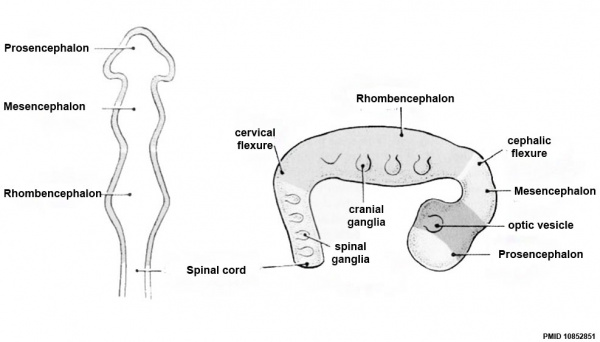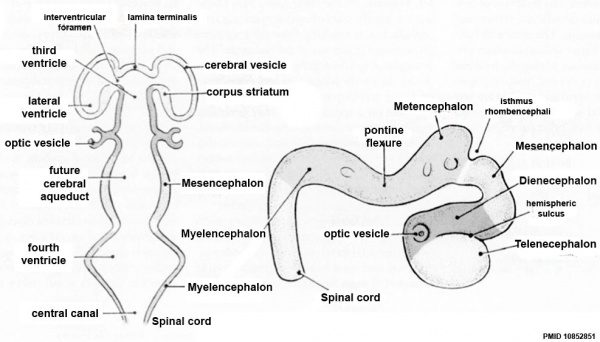Neural - Metencephalon Development: Difference between revisions
(Created page with '<div style="background:#F5FFFA; border: 1px solid #CEF2E0; padding: 1em; margin: auto; width: 98%; float:left;"><div style="margin:0;background-color:#cef2e0;font-family:sans-ser…') |
|||
| Line 19: | Line 19: | ||
|-bgcolor="F5FAFF" | |-bgcolor="F5FAFF" | ||
| | | | ||
* ''' | * '''Role of Lmx1b and Wnt1 in mesencephalon and metencephalon development'''<ref><pubmed>12399317</pubmed></ref> "The isthmus is the organizing center for the tectum and cerebellum. Fgf8 and Wnt1 are secreted molecules expressed around the isthmus. The function of Fgf8 has been well analyzed, and now accepted as the most important organizing signal. Involvement of Wnt1 in the isthmic organizing activity was suggested by analysis of Wnt1 knockout mice. But its role in isthmic organizing activity is still obscure. Recently, it has been shown that Lmx1b is expressed in the isthmic region and that it may occupy higher hierarchical position in the gene expression cascade in the isthmus. We have carried out misexpression experiment of Lmx1b and Wnt1, and considered their role in the isthmic organizing activity. Lmx1b or Wnt1 misexpression caused expansion of the tectum and cerebellum. Fgf8 was repressed in a cells that misexpress Lmx1b, but Fgf8 expression was induced around Lmx1b-misexpressing cells. As Lmx1b induced Wnt1 and Wnt1 induced Fgf8 expression in turn, Wnt1 may be involved in non cell-autonomous induction of Fgf8 expression by Lmx1b. Wnt1 could not induce Lmx1b expression so that Lmx1b may be put at the higher hierarchical position than Wnt1 in gene expression cascade in the isthmus. We have examined the relationship among isthmus related genes, and discuss the mechanism of the formation and maintenance of isthmic organizing activity." | ||
|} | |} | ||
Revision as of 17:47, 7 November 2010
Introduction
Neural development is one of the earliest systems to begin and the last to be completed after birth. This development generates the most complex structure within the embryo and the long time period of development means in utero insult during pregnancy may have consequences to development of the nervous system.
The early central nervous system begins as a simple neural plate that folds to form a groove then tube, open initially at each end. Failure of these opening to close contributes a major class of neural abnormalities (neural tube defects).
Within the neural tube stem cells generate the 2 major classes of cells that make the majority of the nervous system : neurons and glia. Both these classes of cells differentiate into many different types generated with highly specialized functions and shapes. This section covers the establishment of neural populations, the inductive influences of surrounding tissues and the sequential generation of neurons establishing the layered structure seen in the brain and spinal cord.
- Neural development beginnings quite early, therefore also look at notes covering Week 3- neural tube and Week 4-early nervous system.
- Development of the neural crest and sensory systems (hearing/vision/smell) are only introduced in these notes and are covered in other notes sections.
Some Recent Findings
|
Development Overview
Neuralation begins at the trilaminar embryo with formation of the notochord and somites, both of which underly the ectoderm and do not contribute to the nervous system, but are involved with patterning its initial formation. The central portion of the ectoderm then forms the neural plate that folds to form the neural tube, that will eventually form the entire central nervous system.
- Early developmental sequence: Epiblast - Ectoderm - Neural Plate - Neural groove and Neural Crest - Neural Tube and Neural Crest
| Neural Tube | Primary Vesicles | Secondary Vesicles | Adult Structures |
|---|---|---|---|
| week 3 | week 4 | week 5 | adult |
| prosencephalon (forebrain) | telencephalon | Rhinencephalon, Amygdala, hippocampus, cerebrum (cortex), hypothalamus, pituitary | Basal Ganglia, lateral ventricles | |
| diencephalon | epithalamus, thalamus, Subthalamus, pineal, posterior commissure, pretectum, third ventricle | ||
| mesencephalon (midbrain) | mesencephalon | tectum, Cerebral peduncle, cerebral aqueduct, pons | |
| rhombencephalon (hindbrain) | metencephalon | cerebellum | |
| myelencephalon | medulla oblongata, isthmus | ||
| spinal cord, pyramidal decussation, central canal | |||
Early Brain Vesicles
Primary Vesicles
Secondary Vesicles
References
- ↑ <pubmed>12399317</pubmed>
Reviews
<pubmed>19206138</pubmed>
Articles
Search PubMed
Search Pubmed: Metencephalon Embryology | Metencephalon Development |
Glossary Links
- Glossary: A | B | C | D | E | F | G | H | I | J | K | L | M | N | O | P | Q | R | S | T | U | V | W | X | Y | Z | Numbers | Symbols | Term Link
Cite this page: Hill, M.A. (2024, April 27) Embryology Neural - Metencephalon Development. Retrieved from https://embryology.med.unsw.edu.au/embryology/index.php/Neural_-_Metencephalon_Development
- © Dr Mark Hill 2024, UNSW Embryology ISBN: 978 0 7334 2609 4 - UNSW CRICOS Provider Code No. 00098G


